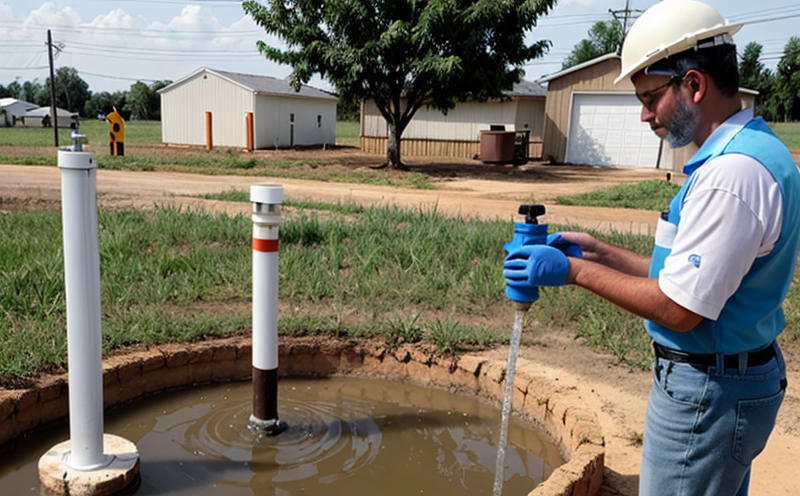ASTM D5088 Groundwater Monitoring Sample Testing
The ASTM D5088 standard provides a comprehensive approach to sampling and testing groundwater for volatile organic compounds (VOCs) and other contaminants. This method is crucial in environmental monitoring, ensuring compliance with regulatory standards and protecting public health.
Groundwater plays a vital role in the ecosystem and human activities, making it essential to monitor its quality regularly. Contamination can occur from various sources such as industrial discharges, agricultural runoff, or improper waste disposal. The ASTM D5088 method addresses these concerns by providing standardized procedures for collecting representative samples of groundwater.
The process begins with the proper selection of sampling points and the use of appropriate equipment to prevent contamination during collection. Once collected, the samples are transported under controlled conditions to a certified laboratory where they undergo rigorous testing according to ASTM D5088 guidelines. The method covers both field and laboratory procedures, ensuring accurate results every time.
ASTM D5088 emphasizes the importance of using clean equipment and techniques throughout the sampling process. This helps in obtaining reliable data that can be used for decision-making processes related to environmental protection. By adhering strictly to these protocols, laboratories ensure consistency across various projects and locations.
The ASTM D5088 standard also includes detailed instructions on how to handle different types of contaminants found in groundwater. Whether it's volatile organic compounds or metals like lead or mercury, this method ensures that all relevant parameters are accounted for during testing. This comprehensive approach makes ASTM D5088 an indispensable tool for anyone involved in environmental monitoring.
In summary, ASTM D5088 is a vital part of any groundwater quality assessment program. It provides the necessary tools and techniques to ensure accurate and reliable results, which are crucial for maintaining clean water resources.
Why It Matters
Groundwater contamination can have severe consequences on both human health and the environment. Contaminants such as volatile organic compounds (VOCs), pesticides, solvents, and heavy metals can pose significant risks if not properly managed. Regular testing of groundwater using methods like ASTM D5088 helps identify these issues early on, allowing for prompt corrective actions to be taken.
Compliance with regulatory requirements is another critical reason why ASTM D5088 should be used in groundwater monitoring programs. Many countries have strict laws regarding the quality of drinking water and surface waters. Using a standardized method ensures that all samples are tested consistently, providing confidence in meeting these standards.
From an economic perspective, preventing costly remediation projects is another benefit of regular testing with ASTM D5088. Early detection of contamination allows for targeted interventions before widespread damage occurs, saving money and resources long-term.
Scope and Methodology
- Sampling: ASTM D5088 specifies the procedures for collecting representative samples of groundwater under various conditions.
- Transportation: The method outlines requirements for transporting collected samples to ensure they remain uncontaminated during transit.
- Laboratory Analysis: Detailed instructions are provided on how to perform laboratory analyses using appropriate instrumentation and techniques.
The ASTM D5088 standard covers a wide range of contaminants, including but not limited to VOCs, pesticides, solvents, and heavy metals. Each type of contaminant has specific testing procedures outlined in the document. For instance, sampling for volatile organic compounds involves different techniques compared to those used for measuring dissolved oxygen levels or pH values.
In addition to specifying the types of analyses that should be conducted, ASTM D5088 also provides guidance on how to interpret results correctly. This includes understanding what constitutes an acceptable level of contamination and knowing when further investigation is necessary.
Benefits
- Accurate Results: By following ASTM D5088, laboratories can ensure that their results are accurate and reliable.
- Consistent Compliance: Using a standardized method guarantees consistent compliance with regulatory requirements across different locations.
- Cost Efficiency: Early detection of contamination helps prevent costly remediation projects in the future.
The use of ASTM D5088 also promotes better decision-making by providing clear data on groundwater quality. This information is crucial for stakeholders involved in environmental protection, public health, and resource management.





